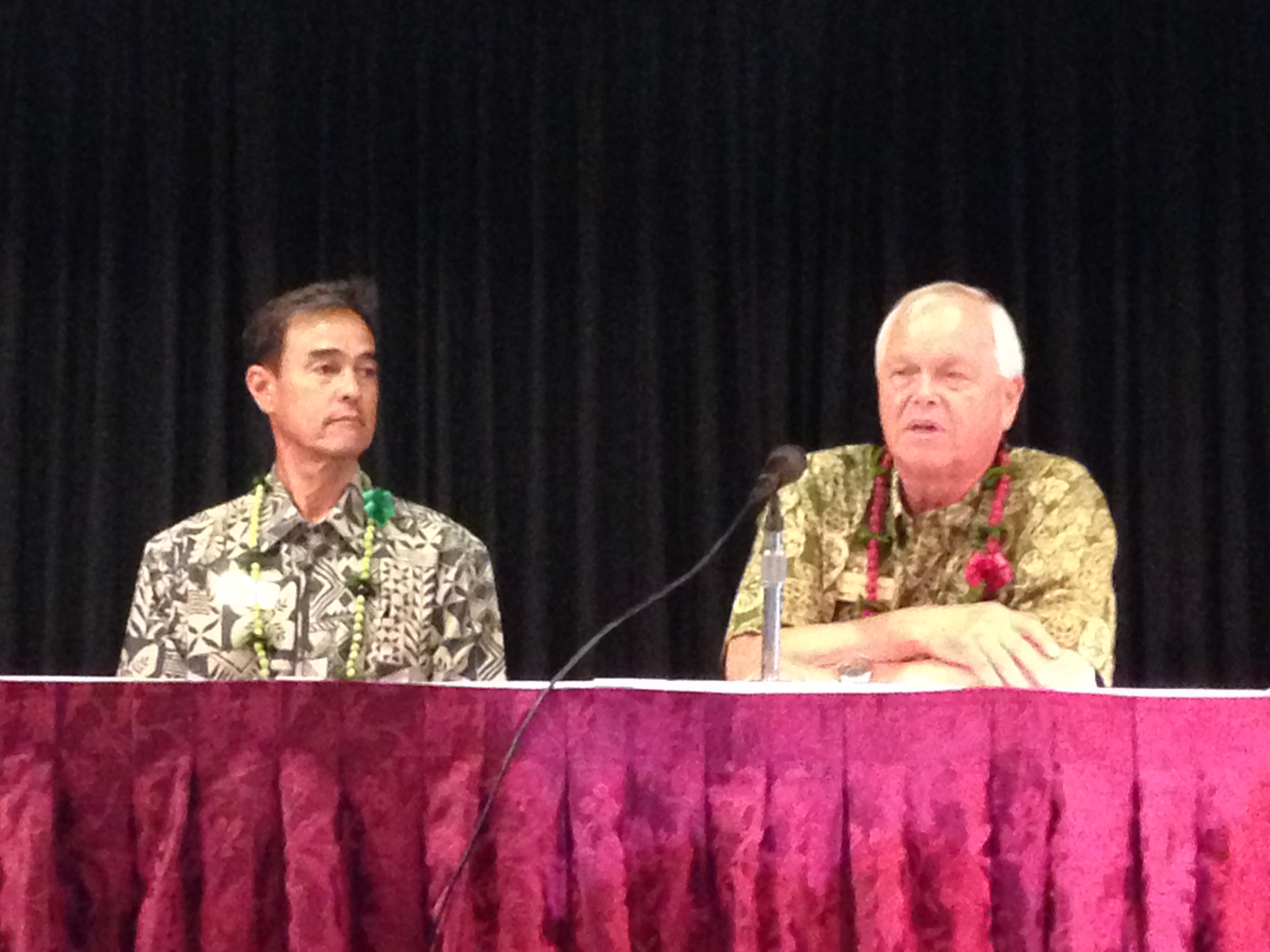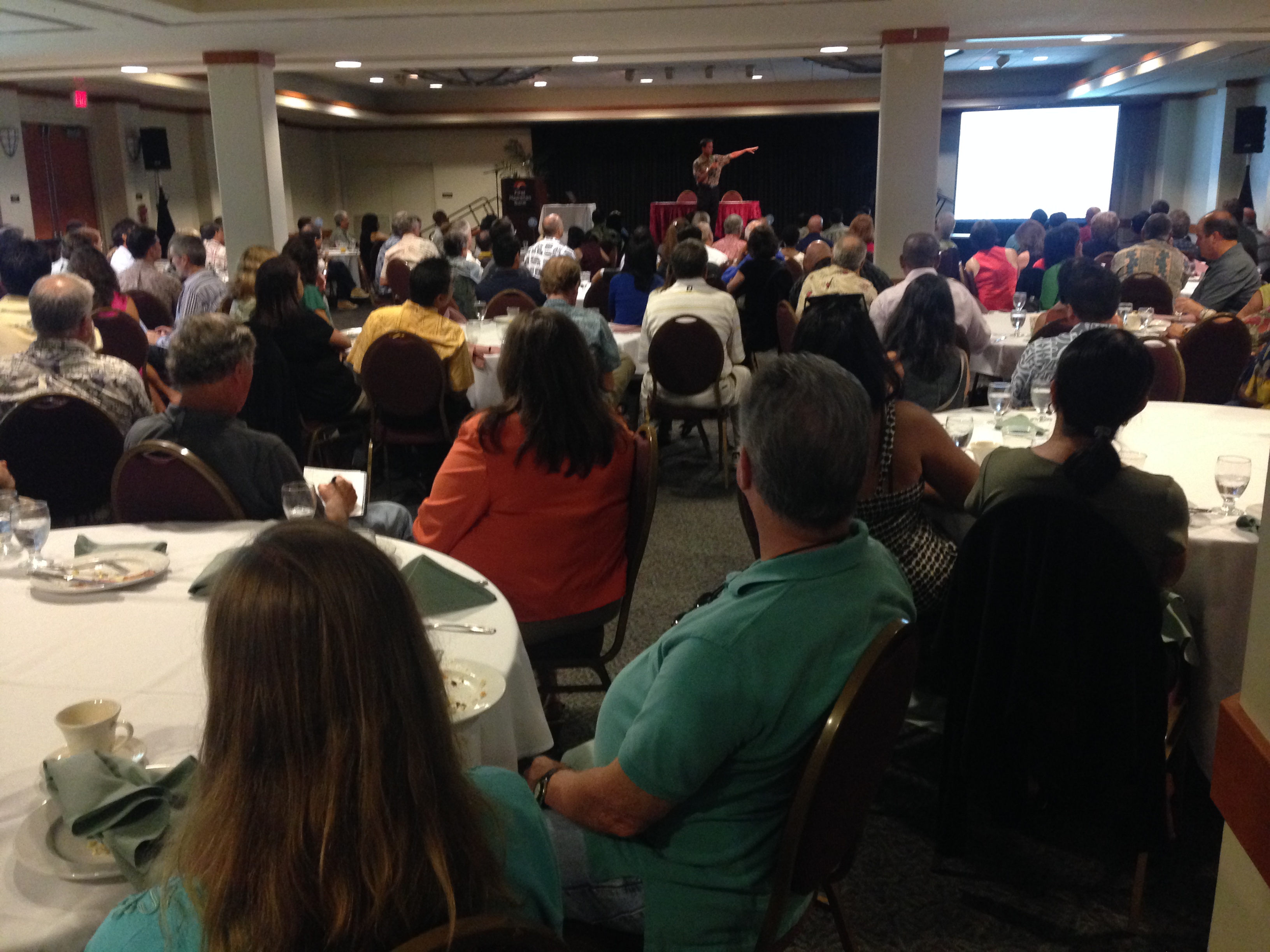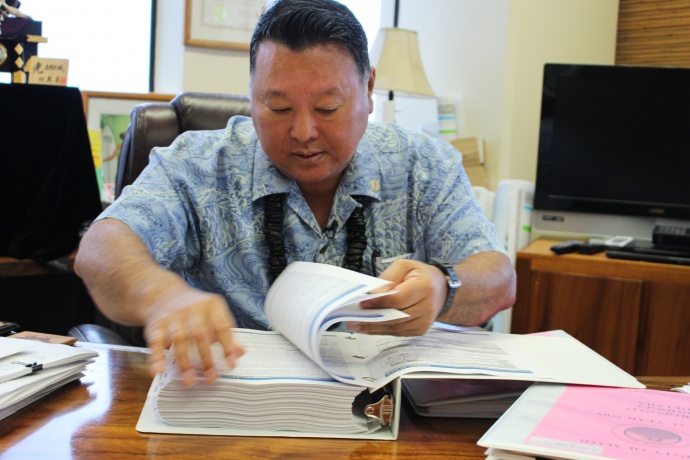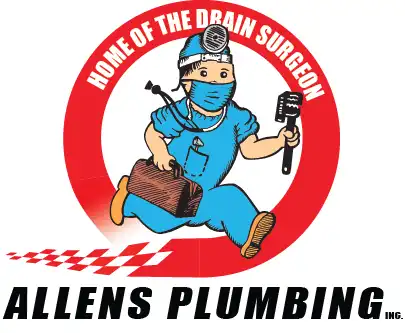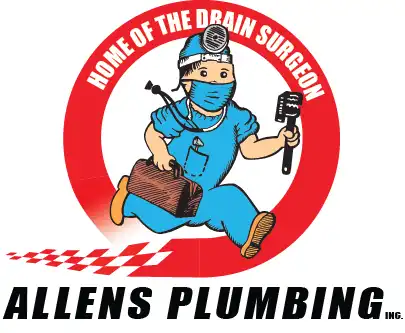Economic Outlook ‘Optimistic;’ Mayor Has Concerns
First Hawaiian Bank held its 41st Annual Economic Outlook Forum yesterday morning at the Maui Beach Hotel in Kahului.
“If I had to pick just one word to summarize my economic outlook for Maui, it would be ‘optimistic,’” said Economist Dr. Jack Suyderhoud, after his update. Dr. Kenneth Miller, the other guest speaker, said that even “if there was going to be a recession, the US is relatively well-positioned, so I think it’s an optimistic outlook.”
However, after the forum, Mayor Alan Arakawa told Maui Now, “With all these economic indicators, we’re talking about a superficial level, because on the ground level, we’ve got some real challenges we’ve got to work on.”
Suyderhoud is an economic adviser and professor of business economics at the Shidler School of Business at the University of Hawai‘i-Mānoa. He presented an overview of Maui County’s economic outlook for 2015-16. Dr. Miller is the senior vice president in First Hawaiian Bank’s Wealth Management Group, who covered the US and global economic perspectives. (See “The US and Worldwide Economic Outlook” below.) Mayor Arakawa is serving his third term in the county’s top position.
Approximately 175 attended the forum, including Rep. Justin Woodson, Councilmembers Stacy Crivello and Gladys Baisa, County Managing Director Keith Regan and Mayor Arakawa, who shared less optimistic views about the island’s future with Maui Now immediately after the update.
“There is much to be happy about in looking at Maui’s economy in 2015 and going into 2016, including tourism, the labor market and construction,” said Suyderhoud during his presentation.
Suyderhoud cited key trends on Maui in the construction industry, visitor sector and labor market.
“Construction, which has been bolstered by public infrastructure, seems ready to break out as commercial construction leads into more residential building activity,” Suyderhoud said.
“The visitor sector has led the way and 2016 looks promising as more capacity comes online,” said Suyderhoud. “Thanks to vibrant tourism, the county’s labor market is strong—almost to the point of not being able to keep up with demand for workers.”
However, Suyderhoud added after the forum, “We shouldn’t be complacent about tourism… there’s competition out there because of the strong dollar and the competitions’ weak currencies. You must keep your eye on the future and make sure Maui is always an attractive visitor market as a quality experience, attracting more wealthy visitors and not necessarily more volume.”
Diversification is also important, said Suyderhoud after the forum, but on Maui, he is concerned about what he sees as resistance to diversification.
“The logical place on Maui to diversify is ag, and what’s happening with ag?” Suyderhoud asked. “The significant employers, HC&S and seed corn companies—people are trying to drive them out of business. That’s the opposite of diversification.”
Legal challenges to these agricultural enterprises as well as the observatory construction on Haleakalā have the potential for substantial economic interruptions, Suyderhoud said.
“MEDB’ STEM programs, AMOS conferences and linking the community with the technology on “the hill” is great stuff,” said Suyderhoud, referring to the ongoing construction of the Daniel K. Inouye Solar Telescope atop Haleakalā. “But the technology on the hill is also under attack.”
Suyderhoud added, “I’m thinking that in 10 years, this economy may be less diversified than it is now.”
“Question marks remain,” Suyderhoud added during his presentation. “A sustainable resolution for Maui Memorial Medical Center’s financial problems is a necessary condition for the island’s long-term outlook.”
In reply to a question from the media after the forum about MMMC’s privatization options, Suyderhoud said, “If privatization doesn’t go through, what you will see for Maui is… staff cuts, service cuts—because the money isn’t there… If privatization does go through, you’ll see a model there of what happened at North Hawai‘i Community Hospital on the Big Island… a public-private partnership. The status quo will not be sustained… something’s gotta give.”
“Assuming no significant changes on these issues, 2016 should be another good year for Maui’s economy,” Suyderhoud concluded in his presentation. (See “Suyderhoud’s Economic Analysis by Sectors of the Economy” below.)
“Much of what was talked about is very, very positive,” Mayor Arakawa told Maui Now after the forum. “However, we so have some challenges that we should be very concerned about that were not mentioned.”
The mayor said his administration is extremely concerned about Maui’s eroding shoreline.
“We have $100,000 in studies and solutions for the problem that were cut by the County Council,” said the mayor. “So we are looking at huge erosion problems in the Lahaina and Kā‘anapali areas, by S-Turns and Napili, but we are going to delay—by the very least, a year—any workable solutions. That may cause the buildings there to tumble into the ocean. That would be a huge problem, because the council won’t address it.”
The mayor also expressed concerns about Maui’s homeless situation.
“When we’re looking at the homeless, everyone just thinks about the people that are on the streets,” the mayor said. “But we have a huge problem with affordable housing.”
“We have several thousand vouchers out there right now for Section 8 housing for people who are having a hard time,” the mayor said. “Because of the lack of inventory, people who have the vouchers have not been able to get units—they can’t even rent them—and it’s going to cause a real problem when the federal government starts taking away our vouchers because of lack of use.
The mayor continued, “So, the fact that the council has been stymieing efforts to create affordable housing—no matter what the rhetoric—their actions have shown very clearly that they don’t care about affordable housing and we’re going to run into some real challenges.
“When we’re looking at numbers that say $400,000 to $500,000 is the median price for workforce housing—how many can afford that who are actually working?” the mayor asked. “They are creating a huge problem… just a handful of guys on the council who have no clue of the danger they are creating.
“But the administration is trying to rectify some of this,” the mayor said. “The council just has to get out of the way and start allowing the fast-track housing and affordable housing to be built. And they must start looking at funding the program that is trying to deal with the homeless.
“Ka Hale A Ke Ola, the affordable housing program on Maui, has literally helped keep thousands off of the homeless rosters,” the mayor said. “Thousands of people have gone through that program, and all of them would be in the homeless category right now if not for that help.”
Ka Hale A Ke Ola is a comprehensive resource center that provides emergency shelter, transitional housing, adult education and training, counseling, a primary care medical clinic and facilities for childcare. Existing facilities are in Wailuku and Lahaina.
“We were going to build one in Kīhei, but the council cancelled that project,” said the mayor. “They’re making no effort to help house the homeless—specifically Mike White and Riki Hokama.”
White is the chair of the County Council; Hokama is the chair of its Budget and Finance Committee.
“They’re leading this charge,” said the mayor. “They’re going to create a huge homeless problem for the workforce we have right now who are currently using our Section 8 rentals, when we lose our Section 8 rentals. It’s very serious. With all these economic indicators, we’re talking about a superficial level—because on the ground level, we’ve got some real challenges we’ve got to work on.”
Suyderhoud’s Economic Analysis by Sectors of the Economy
Tourism
“The importance of tourism to Maui County’s economy cannot be overstated,” Suyderhoud said. “Compared to the state as a whole, Maui is almost three times as reliant on tourism. US visitors dominate Maui’s tourism market, accounting for 72 percent of all arrivals. This has been good for Maui since the US market has been strong, while Canada has been flat and Japan was down by 24 percent last year. In 2014, despite the Japanese decline, Maui visitor arrivals reached over 2 million—the highest total since 2007.
“Average length of stay remained strong in 2013, 2014 and into 2015,” said Suyderhoud. “Improved arrivals and visitor days have caused total visitor spending to double since the 2008-09 doldrums. However, visitor spending per day has barely budged between 2007 and 2013, and actually fell in inflation-adjusted terms.”
He said airline decisions on flight capacity are benefiting Maui, which leads the state in seat growth from both domestic and Canadian origins.
“If the US government works out a pre-clearance arrangement for visitors traveling from Narita and other Japanese airports, direct service from these markets to Maui will become more likely,” Suyderhoud said. “At some point, the capacity of Kahului airport will become an issue. Already, plans are being made for adding two jetways at the commuter end of the building.”
Suyderhoud noted that tourism facility owners have continued to invest in properties such as the Mākena Resort, Maui Lu, Kā‘anapali Ocean Resort and Kā‘anapali Ali‘i. Even the Maui Palms property will be resurrected as a 174-room hotel, he said, and Whaler’s Village has started a $26 million renovation to be completed in late 2016.
Labor Market
“Robust tourism has helped the Maui labor market continue to recover from the Great Recession,” Suyerhoud said. “Since 2010, Maui has added nearly 9,000 jobs—most of those in the restaurant and lodging sectors, increasing the total jobs in the county to within 1,300 of the pre-recession peak. Maui’s unemployment rate, well above the statewide average in 2009, has declined even faster than that of the state and is now equal to the state average of about 4%.”
“Low unemployment is good news, but comes with a cost to employers, who are starting to have trouble hiring skilled workers such as machine operators,” Suyderhoud said. “Likewise, hiring less-skilled workers and middle managers has become harder and more expensive as potential employees have more options in the strong economy.”
Construction
“For several years, we have been hoping that the good tourism news would spread to the construction sector,” Suyderhoud said. “While this still has not yet occurred broadly, there are glimmers of hope. Only about 1,100 construction jobs have been added since the 2010 trough. Total construction jobs remain 1,600 below the pre-recession peak.”
Suyderhoud said residential construction has been “moribund for the better part of six years,” but recently there has been an uptick in the value of permits. In 2009, total private permits averaged less than $20 million per month; by 2014 this had increased to nearly $37 million.
“In 2015, all categories of private permits are up significantly, foreshadowing accelerating construction into 2016,” he said.
Suyderhoud said residential development will see a boost from the county’s decision to relax the constraints of the residential workforce requirements. About 1,400 residences are planned for Waikapū, and A&B has plans for 1,600 units at various locations, he said.
But Suyderhoud said there is some concern that commercial development will create more space than can be supported by present absorption rates. Vacancies and the resulting rents will control the growth of commercial development payoffs.
The county’s effort to improve infrastructure is continuing, focusing on roads, parks, wastewater treatment and consolidation of the county base yards, Suyderhoud said. The county purchased 4.1 acres in the Maui Business Park to consolidate services and get out from under lease costs, and state construction includes the new airport access road and a $340 million airport car rental facility.
“At some point, private activity will have to pick up to fill in for the completion of public projects,” Suyderhoud said.
Real Estate
“The real estate recovery from the Great Recession is almost complete, especially for the condominium market,” Suyderhoud said. “Condo sales recovered to their 2007 levels back in 2012. Single-family unit sales grew smartly through 2013, leveled off in 2014, but are on the upswing again in 2015. Reflecting strong market demand, prices have also recovered well from the 2011 low. While prices have not yet returned to 2007 levels, the increases have been steady and solid.”
“While 2015 is expected to be a good year for the single-family market, there are concerns that the condominium market will soften due to declining demand from Canadian buyers whose purchasing power is being eroded by the strong US dollar,” said Suyderhoud.
He summarized the progress of Maui’s major real estate projects:
New Maui Lani residential properties are building out and selling.
The Tradition project by D. R. Horton is almost sold out.
The Parkways Phase I sold all 40 units, and Phase II has 45 units of which a third have been sold.
Maui Lani will start grading another 45 acres for 500 units that are 51% affordable.
A&B’s residential project in Kīhei will start with an increment of about 170 affordable units to reach market in 2018. This project will build out to over 600 units.
At Wailea, A&B will commence sales later this year for their Keala O Wailea project, 70 condominiums priced in the high $800,000 to low $1 million range.
“Commercial real estate is also doing well,” Suyderhoud said. “A&B Properties has seen brisk sales at strong prices—$40 per square foot—in the Maui Business Park South project. Maui Lani is finding strong demand for its office and warehouse properties.”
Agriculture
“Maui agriculture has become increasingly controversial but remains an important part of the county’s economy,” Suyderhoud said.
He said last year’s wet weather kept the HC&S sugar yield down to 172,000 tons—less than the hoped-for 190,000. Above-normal rain will also keep this year’s yield below HC&S’ goal.
“Sugar prices have been helped by countervailing duties imposed by the US International Trade Commission on Mexican sugar imports, but US prices remain at about $.24 per pound,” Suyderhoud said. “Employment at HC&S stands at 750, down from 800 about a year ago, mostly due to attrition of older workers who have not been replaced.”
“The seed corn companies continue to be major contributors to the economy,” Suyderhoud continued. “While these companies were successful in fighting off restrictive legislation at the state level, the outcome of county level initiatives is in the hands of the courts. The supply chain infrastructure created by the seed companies also benefits diversified agriculture in the county. For example, extension services estimate there are about 50 full-time vegetable farmers growing everything from sweet potatoes to zucchini.”
Healthcare
“Maui Memorial Medical Center is the second largest employer in the county,” said Suyderhoud. “After years of financial woes, new legislation may allow privatization. If it does become privately operated, there will be relative financial stability, which will allow for expansion of services and even job growth. The Maui community as a whole needs a reliable, modern medical infrastructure. Without it, Maui becomes a much less attractive place to live and invest.”
Higher Education
“UH Maui College continues to fulfill a crucial role in providing well-qualified, creative graduates to Maui’s workforce,” said Suyderhoud. “Enrollments are down slightly as the labor market has improved. Leveraging local advantages, UHMC has opened the Daniel K. Inouye Allied Health Center housing the dental hygiene program, and is moving ahead on its Food Innovation Center and Hotel Ha, a teaching hotel for visitor industry students.”
Haleakalā
“Haleakalā observatories involve seven mountaintop facilities,” Suyderhoud said. “According to the UH Institute for Astronomy, the annual operating budget of Maui facilities is about $40 million, supporting about 170 county-based staff.”
“The Daniel K. Inouye Solar Telescope is a $340 million project with a 2019 completion date,” Suyderhoud continued. “Since 2012, it is estimated that $40 million has been spent in Hawai‘i and an additional $160 million elsewhere for structures and equipment. It is now half completed, and once finished, the annual operating budget will be $13 million in today’s dollar values with 35 local staff. However, uncertainty hovers around this project in the form of two pending Supreme Court cases.”
Lāna‘i
“Pulama Lāna‘i, the operating company for Lāna‘i’s owner, has focused on renovating the Manele Bay Resort, which closed June 1 to focus on common-area improvements, including the pool,” Suyderhoud said. “The strategy is to develop a low-density, high-dollar visitor experience using the Four Seasons brand. The room count at Manele will come down from 248 to 217 when it reopens.”
Suyderhoud said The Lodge at Koele was shut down in January to house construction workers, and it too will reopen in early 2016. The company has also renovated 180 rental units for workforce housing and has not laid off hotel staff during construction.
“Rather, they have reassigned these workers to community service and improvement projects,” Suyderhoud said.
Moloka‘i
“Moloka‘i remains a fragile and vulnerable economy,” said Suyderhoud. “When Moloka‘i Ranch shut down, 120 jobs were lost. If the seed corn companies are driven out by regulatory pressures, 300 more would be lost.”
The island has embarked on a 10-year community plan aiming to identify sustainable options that leverage its special features, Suyderhoud said.
“There has been some talk that Moloka‘i Ranch may bring back investors and reopen the Kaluakoi Resort, but nothing definitive has occurred,” Suyderhoud said. “The biggest step would be a clear signal from the community that investment would be welcomed.”
The US and Worldwide Economic Outlook
“Obviously there’s a lot going on in the markets in the last month,” said Dr. Miller. “Given what happened with the stock prices dropping by the most we’ve had in five years, the question that comes to my mind is, is this telling us something about what’s happening in the global market? Given that the stock market is generally considered to be a pretty reliable indicator of future economic growth, does this mean we’re on the cusp of a recession?”
Explaining in detail the numerous factors that affect world and national economies, Dr. Miller said the global economy has downshifted into low gear in the aftermath of the 2008 financial crisis, expanding only 3.4% rate over the past three years, down from a 5.1% rate during the five pre-crisis years—2003-07.
Dr. Miller predicts growth of only 3.3% in 2015. But, he said, growth should be stronger this year compared to last year in advanced economies, but weaker in emerging markets. By next year, both are projected to show mild acceleration, bringing the global growth rate to 3.8%
In summary, Miller said, “I think that we’re are in for continued sluggish growth, but I don’t think that we’re on the cusp of a recession.”
In other words, the economy will be slow going, but growing.
To read the full report, click FHB Maui Forecast 2015-16 or go online.



